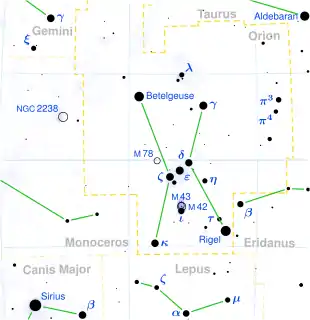15 Orionis
15 Orionis is a suspected astrometric binary[9] star system in the equatorial constellation of Orion, near the border with Taurus. It is visible to the naked eye as a faint, yellow-white hued star with an apparent visual magnitude of 4.82.[2] The system is approximately 340 light years away from the Sun based on parallax. It is moving further from the Earth with a heliocentric radial velocity of +29 km/s,[4] having come to within 69 light-years some three million years ago.[5]
| Observation data Epoch J2000 Equinox J2000 | |
|---|---|
| Constellation | Orion |
| Right ascension | 05h 09m 41.96481s[1] |
| Declination | 15° 35′ 49.9051″[1] |
| Apparent magnitude (V) | 4.82[2] |
| Characteristics | |
| Spectral type | F2IV[3] |
| U−B color index | +0.19[2] |
| B−V color index | +0.32[2] |
| Astrometry | |
| Radial velocity (Rv) | +28.79[4] km/s |
| Proper motion (μ) | RA: −3.105[1] mas/yr Dec.: –3.444[1] mas/yr |
| Parallax (π) | 9.5097 ± 0.2951[1] mas |
| Distance | 340 ± 10 ly (105 ± 3 pc) |
| Absolute magnitude (MV) | −0.04[5] |
| Details | |
| 15 Ori A | |
| Mass | 3.42±0.67[6] M☉ |
| Radius | 5.9[7] R☉ |
| Luminosity | 300[6] L☉ |
| Surface gravity (log g) | 3.75[8] cgs |
| Temperature | 7,161+50 −49[6] K |
| Metallicity [Fe/H] | +0.21[8] dex |
| Rotational velocity (v sin i) | 60[6] km/s |
| Other designations | |
| Database references | |
| SIMBAD | data |
The primary component is an early F-type subgiant star with a stellar classification of F2 IV,[3] a star that has exhausted the hydrogen at its core and has begun to evolve into a giant. It has 3.42[6] times the mass of the Sun and 5.9[7] times the Sun's radius. The star still has a relatively high rotation rate, showing a projected rotational velocity of 60 km/s.[6] It is radiating 300 times the luminosity of the Sun from its expanding photosphere at an effective temperature of 7,161 K.[6]
It has one suspected companion, component B, at a separation of 0.3".[10]
References
- Brown, A. G. A.; et al. (Gaia collaboration) (August 2018). "Gaia Data Release 2: Summary of the contents and survey properties". Astronomy & Astrophysics. 616. A1. arXiv:1804.09365. Bibcode:2018A&A...616A...1G. doi:10.1051/0004-6361/201833051. Gaia DR2 record for this source at VizieR.
- Ducati, J. R. (2002). "VizieR Online Data Catalog: Catalogue of Stellar Photometry in Johnson's 11-color system". CDS/ADC Collection of Electronic Catalogues. 2237. Bibcode:2002yCat.2237....0D.
- Hoffleit, D.; Warren, W. H. (1995). "VizieR Online Data Catalog: Bright Star Catalogue, 5th Revised Ed. (Hoffleit+, 1991)". VizieR On-line Data Catalog: V/50. Originally Published in: 1964BS....C......0H. 5050. Bibcode:1995yCat.5050....0H.
- Massarotti, Alessandro; Latham, David W.; Stefanik, Robert P.; Fogel, Jeffrey (2008). "Rotational and Radial Velocities for a Sample of 761 Hipparcos Giants and the Role of Binarity". The Astronomical Journal. 135: 209. Bibcode:2008AJ....135..209M. doi:10.1088/0004-6256/135/1/209.
- Anderson, E.; Francis, Ch. (2012). "XHIP: An extended hipparcos compilation". Astronomy Letters. 38 (5): 331. arXiv:1108.4971. Bibcode:2012AstL...38..331A. doi:10.1134/S1063773712050015. Vizier catalog entry
- Zorec, J.; Royer, F.; Asplund, Martin; Cassisi, Santi; Ramirez, Ivan; Melendez, Jorge; Bensby, Thomas; Feltzing, Sofia (2012). "Rotational velocities of A-type stars. IV. Evolution of rotational velocities". Astronomy and Astrophysics. 537: A120. arXiv:1201.2052. Bibcode:2012A&A...537A.120Z. doi:10.1051/0004-6361/201117691.
- Allende Prieto, C.; Lambert, D. L. (1999). "Fundamental parameters of nearby stars from the comparison with evolutionary calculations: Masses, radii and effective temperatures". Astronomy and Astrophysics. 352: 555. arXiv:astro-ph/9911002. Bibcode:1999A&A...352..555A. Vizier catalog entry
- Wu, Yue; Singh, H. P.; Prugniel, P.; Gupta, R.; Koleva, M. (2010). "Coudé-feed stellar spectral library – atmospheric parameters". Astronomy & Astrophysics. 525: A71. arXiv:1009.1491. Bibcode:2011A&A...525A..71W. doi:10.1051/0004-6361/201015014.
- Eggleton, P. P.; Tokovinin, A. A. (September 2008), "A catalogue of multiplicity among bright stellar systems", Monthly Notices of the Royal Astronomical Society, 389 (2): 869–879, arXiv:0806.2878, Bibcode:2008MNRAS.389..869E, doi:10.1111/j.1365-2966.2008.13596.x.
- Mason, Brian D.; Wycoff, Gary L.; Hartkopf, William I.; Douglass, Geoffrey G.; Worley, Charles E. (2001). "The 2001 US Naval Observatory Double Star CD-ROM. I. The Washington Double Star Catalog". The Astronomical Journal. 122 (6): 3466. Bibcode:2001AJ....122.3466M. doi:10.1086/323920. Vizier catalog entry
